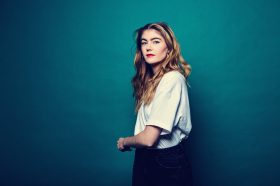Robin Fox – Colour Organ, Image by MONA/Rémi Chauvin. Image Courtesy MONA Museum of Old and New Art, Hobart, Tasmania, Australia
Led by the Tasmanian Symphony Orchestra (TSO) and creative trio Simon Rogers, Marko Letonja and Brian Ritchie, the two-day event Synaesthesia+ presented solo and ensemble performances placed around the gallery spaces as a follow on from the highly praised 2012 instalment.
The Museum of OId and New Art (MONA) was closed to the general public and transformed into a sensory wonderland as a few hundred guests immersed themselves in a program inspired by the phenomenon of synaesthesia – the cognitive condition where music has been known to stimulate the senses in strange and interesting ways.
Kicking things off was Matthew Hindson’s new commission Resonance, presented by groups of TSO in pockets around MONA. Sounds from the cellists and violinists echoed through the halls culminating towards an epic finale in the famed Nolan gallery.
Joining the TSO was Richard Tognetti’s Violin Concerto of Ligetti – a delight to witness as it played out across the three movements. The strange yet haunting piece was heightened by the erratic yet disturbing splash of light and projection across the gallery space.
In the Void, Genevieve Lacey’s solo took place under just one dim spotlight, with the mash of her recorder against supporting soundscapes a complete saturation of the senses that expressed the chaos of the subconscious mind.
Lacey’s Sunday performance of Elena Kats-Chernin’s Renditions with the TSO reimagined Bach as a standout piece of the program, heightened by pristine acoustics and a changing lighting design that mimicked the mood of the music.
One of the most interactive elements of the program was Colour Organ by projection artist Robin Fox. Hidden away in the depths of the Library Gallery, visitors became artists as a keyboard allowed for one to manipulate of laser projections across the space in what could only be described as sensory overload.
During Pierrot Lunaire, award-winning soprano Alison Bell commanded Schoenburg’s strange, atonal scales with technical precision and incredible control in the depths of the Organ Room. The sad story of the clown was delivered in German as a mix of singing and spoken word and was both intriguing and unsettling.
In Black Bach, TSO chorus members led by chorus master June Tyzack performed Bach chorales in complete darkness in the Barrel Room. Among the smells of wine barrels, combined with the displaced voices in darkness, was an interesting play on audible sounds and combined singing, whispering spoken word and even spitting sounds as a reflection of the subconscious mind.
Across the weekend, interdisciplinary artist Karen Casey featured Brian Ritchie in a Monash University research project charting brainwave activity and their relationship to music through the use of EEG equipment. The presentation gave insights to visitors about the creative process in innovative new way.
Seemingly, organisers had planned out the event well, with programming across the weekend allowing for multiple viewings of the same artists, or the chance to dash around the gallery and catch as many performances as possible. With equally amazing was the food on offer, Synaesthsia+ certainly delivered on it’s premise to excite the senses.





